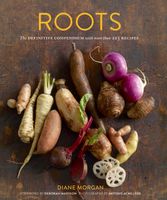Save 25% on ckbk Premium Membership with code FALLFLAVORS 🍁
History and Lore
By Diane Morgan
Published 2012
The name of this root is confusing, and there is much speculation as to its origin, since it does not come from Jerusalem and is not a type of artichoke, though both are members of the aster family. One suggested source was an early-seventeenth-century description of the tuber by the explorer Samuel de Champlain, who described its flavor as tasting like an artichoke. The suggested explanation for the word Jerusalem is that it is an English corruption of the Italian word girasole and the Spanish gerasol, both of which mean “sunflower.” However, it is also suggested that Jerusalem is a corruption of Terneuzen, a city in the Netherlands from which the tubers were introduced to England. The overwhelming popularity of the potato reduced these oddly named vegetables to a minor crop in most parts of the world. Today, however, with the proliferation of farmers’ markets and specialty growers and the interest of chefs, these crisp, sweet, nutty-tasting tubers are making their way back into the U.S. culinary repertoire.
Become a Premium Member to access this page
Unlimited, ad-free access to hundreds of the world’s best cookbooks
Over 160,000 recipes with thousands more added every month
Recommended by leading chefs and food writers
Powerful search filters to match your tastes
Create collections and add reviews or private notes to any recipe
Swipe to browse each cookbook from cover-to-cover
Manage your subscription via the My Membership page
Part of
Advertisement
Advertisement


